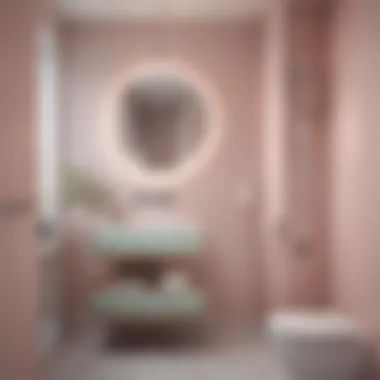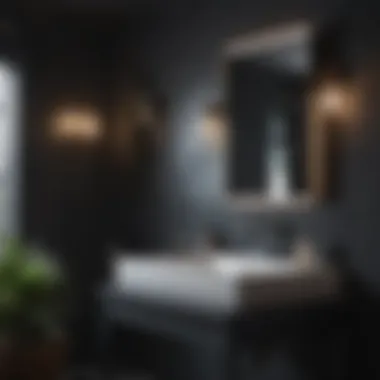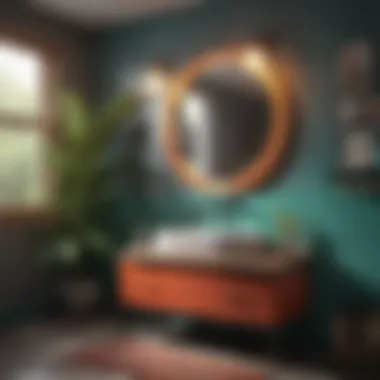Optimal Color Choices for Small Bathrooms


Intro
Choosing the right colors for small bathrooms is essential for transforming these confined spaces into serene retreats. Colors can have profound impacts on perception, mood, and even functionality. Understanding how different colors interact with space is crucial for homeowners and design enthusiasts alike.
In a small bathroom, the use of color is not just a matter of aesthetics; it can define the atmosphere and enhance the experience one has while using the space. Colors can create illusions of spaciousness or coziness, and they can influence the amount of natural light that reflects off surfaces. This article will delve into optimal color choices and the implications of various palettes, providing insights that can elevate the design of any small bathroom.
Design Inspiration
Current Trends in Interior Design
When it comes to small bathrooms, current trends emphasize light and airy colors. Shades like soft whites, light grays, and pastel tones are gaining popularity as they help to expand visual space. Minimalist design also plays a pivotal role; fewer decorations or bold designs can keep the area feeling open and fresh.
Using a monochromatic color scheme is another trend that has gained traction. This method employs various tints and shades of a single color, providing depth without overwhelming the senses. Another notable trend includes the utilization of bold accent walls, which can add character without consuming much space.
Color Schemes and Palette Ideas
Selecting the right color scheme is crucial in smaller bathrooms. Here are a few effective palettes:
- Soft neutrals: Light beige, soft cream, or pale gray can create a calm, soothing environment.
- Monochromatic schemes: Employing one color in various tones can provide a sense of unity while making the space appear larger.
- Pastel hues: Light blues, greens, or yellows can evoke feelings of tranquility and freshness, resembling spa-like settings.
- Bold contrasts: One bold color paired with white or soft neutrals can create impactful visuals while maintaining balance.
"Color is the keyboard, the eyes are the harmonies, the soul is the piano with many strings." – Wanda K. Nita
Careful selection of paint finishes also matters. While matte finishes may absorb light, semi-gloss or satin can reflect it, helping to brighten the space.
Understanding Color Theory
Color theory serves as a fundamental concept in design, offering valuable insight into how colors can influence perception and emotion. In the context of small bathrooms, understanding color theory is essential. The right colors can not only make a space appear larger but can also create a soothing environment.
By grasping the principles of color theory, homeowners and design enthusiasts can make informed choices that enhance both functionality and aesthetics. A small bathroom can easily feel constrictive, but through strategic color selection, it can be transformed into a serene retreat.
This section will explore the basics of color theory and its psychological impacts on individuals in a confined space.
The Basics of Color Theory
Color theory encompasses a variety of guidelines that can help in selecting colors effectively. At its core, colors can be primary, secondary, or tertiary. Primary colors are red, blue, and yellow. Combining these colors creates secondary colors like orange, green, and purple. More complex variations arise from blending secondary colors, resulting in tertiary colors. Understanding this hierarchy is crucial in choosing a cohesive color palette.
Additionally, the color wheel is a useful tool. It displays colors in a circular format and illustrates relationships between them. Complementary colors, which are opposite on the wheel, create contrast, making them visually striking. On the other hand, analogous colors, which sit next to each other, generate harmony and a soothing effect.
Utilizing the color wheel allows designers to mix and match colors thoughtfully, ensuring that choices enhance the small bathroom while avoiding visual chaos.
The Psychological Impact of Colors
Colors have profound psychological effects that can vary depending on context and personal experience. Cool colors, such as blues and greens, typically evoke calmness and tranquility. These hues are ideal for small bathrooms where relaxation is desired. In contrast, warm colors, like reds and yellows, can energize and stimulate the mind. However, in a limited space, these colors might become overwhelming if used excessively.
A useful approach is to consider the room's purpose. For instance, a spa-like atmosphere can be achieved through deeper blues or soft greens. To break the monotony, adding warm accent colors can spice things up and create focal points.
"Colors are the smiles of nature."
— Leigh Hunt
Understanding how color can alter perception is key. A bathroom painted in light shades creates an illusion of more space. Dark colors can compress a room visually, making it feel even smaller. Therefore, balancing colors, and knowing when to use light or dark shades, is necessary for optimal design.
In summary, mastering the basics of color theory and recognizing the psychological effects of colors enables effective decision-making for small bathrooms. These principles lay the groundwork for how color can positively shape the way a space is experienced, ultimately leading to carefully considered choices.
Importance of Color in Small Spaces
Color plays a vital role in how we perceive spaces, especially in smaller environments such as bathrooms. The right choice of color can create illusions of space and enhance the overall ambiance. In the context of small bathrooms, it becomes imperative to understand how color can not only influence aesthetics but also functionality.
When selecting a color palette, homeowners need to consider how light interacts with colors, and how certain hues can manipulate the perception of size. This can ultimately affect how comfortable and inviting the bathroom feels.
Color and Spatial Illusion


Using light colors is a well-established technique to create an impression of larger space. Soft whites, pale creams, and delicate pastels can reflect light, making the area seem brighter and more open. Darker shades, while potentially stylish, often absorb light, leading to a more confined feeling. Hence, if a small bathroom is painted dark navy blue, it may give a more cramped sensation compared to a lighter shade.
Key Strategies for Creating Spatial Illusions:
- Select colors from the same color family to maintain visual continuity.
- Use glossy finishes on paint or tiles to enhance light reflection further.
- Incorporate vertical stripes in wall design to guide the eye upwards, emphasizing height.
Maximizing Light with Color Choices
Proper color choices can significantly maximize light in a small bathroom. Natural light is crucial for creating an inviting atmosphere. When considering colors, it is important to think about how they may interact with existing natural and artificial lighting. For instance, a bright, pale yellow can reflect sunlight beautifully, contributing to a warm glow.
On the other hand, colors that absorb too much light can make the space feel oppressive. It is also worth noting that the direction of the natural light entering the bathroom affects how colors are perceived.
Important Considerations for Color and Light:
- Assess the bathroom's orientation. South-facing bathrooms can handle warmer hues, while north-facing ones benefit from cooler colors.
- Consider the type of artificial light—warm LED bulbs can create different effects compared to cool white lights.
- Experimenting with color samples on the walls before finalizing a choice can reveal unforeseen interactions with lighting conditions.
"Color can dramatically transform the perception of space, making it essential to choose wisely in confined areas."
Popular Color Palettes for Small Bathrooms
Choosing the right color palette for a small bathroom is crucial in creating an inviting and spacious atmosphere. Color not only adds aesthetics but also influences how a space feels. A well-thought-out palette can create balance, harmony, and even a sense of openness that can significantly enhance a small bathroom's utility. Homeowners and design enthusiasts must consider how these colors interplay with light and fixtures to maximize the space's potential.
Neutral Tones
Neutral tones, such as whites, beiges, and grays, are often the go-to choice for small bathrooms. These shades provide a calming backdrop that can make the space feel more open and larger. Naturally, light colors reflect more light, which is essential in compact areas that might lack ample windows.
Benefits of Neutral Tones:
- Versatility: Neutral colors easily complement various design styles, from contemporary to classic.
- Timelessness: They remain in vogue, shielding the homeowner from the need for frequent updates.
- Enhanced Natural Light: Light neutrals amplify daylight, giving the illusion of a more spacious environment.
When selecting neutral tones, consider the undertones. Warmer whites can impart a cozy climate, while cooler grays can create a sleek, modern effect. To maintain interest, incorporate textures through materials like tiles, countertops, or even wallpaper.
Soft Pastels
Soft pastels present a delightful alternative for those who seek color without overwhelming the senses. Shades like soft pinks, mint greens, and light blues can introduce a whimsical touch while maintaining a serene atmosphere.
Considerations for Soft Pastels:
- Layering Effects: Using a monochromatic scheme with varying pastel shades can create a cohesive and sophisticated look.
- Psychological Comfort: Pastel colors promote relaxation, essential in a space dedicated to self-care, such as a bathroom.
- Accentuation Possibilities: Soft pastels can serve as a perfect backdrop for darker fixtures or accents, providing balance.
In small bathrooms, balance is vital. Limit the use of multiple pastel shades to avoid a cluttered look. Instead, choose one or two main pastel colors to work with.
Bold Accent Colors
While bold accent colors can be daunting, they can lend personality and vibrancy to a small bathroom when applied thoughtfully. Colors like deep navy, charcoal, or even vivid reds can provide striking contrast.
Effective Use of Bold Colors:
- Focal Points: Use bold colors for feature walls or small sections, like the back of a shower or cabinetry, to draw the eye.
- Visual Interest: Bold accents can break up the monotony and add depth to a small space, making it feel layered.
- Contrast: These colors can punctuate a neutral palette effectively, enriching the entire design.
It's crucial not to overdo it. Pair bold colors with lighter tones to ensure the bathroom does not feel confining. Striking the balance between boldness and neutrality can create a dynamic yet comfortable environment.
"Color choices in small bathrooms significantly influence perception and mood. Selecting the right palette is a key step in design."
Case Studies: Successful Color Implementations
Exploring case studies offers a practical perspective on color choices, permitting one to assess various applications and outcomes. These real-life examples illustrate not only the aesthetic appeal but also the functionality of specific color implementations in small bathrooms. By closely examining successful color schemes, homeowners and designers can cultivate a deeper understanding of which colors work well together, as well as how to manipulate space effectively. This section serves as a guide for inspiration while highlighting essential considerations for achieving a balanced and inviting atmosphere.
Minimalist Designs


Minimalist bathroom designs often emphasize simplicity and clarity. The color palette in such spaces typically leans towards neutral shades, focusing on whites, grays, and soft beiges. These choices contribute to a more spacious feel and create a clean backdrop for essential elements such as fixtures and decor.
One notable case is a New York apartment featuring a compact bathroom where a crisp white was utilized on the walls. Coupled with matte black fixtures, this stark contrast enhances the minimalist aesthetic. The result is a clean and sophisticated space where the use of monochromatic shades delivers sophistication without overwhelming the senses. Here, the lighting plays a crucial role; natural light plays into the reflective quality of white, amplifying brightness.
Key considerations in minimalist designs:
- Simplicity: Limit color choices to maintain focus and clarity.
- Texture: Introduce different materials to add depth, compensating for the lack of color.
- Functionality: Ensure that colors do not distract from the utility of the space, making it easier to navigate and use.
Eclectic Styles
Eclectic styles embrace a mix of colors, patterns, and textures. Characterized by a creative confluence of multiple design elements, this approach allows for personal expression and uniqueness. A small bathroom in a historic home serves as an excellent example of this style, where rich teal walls contrast against warm wood accents and vibrant towels.
In this particular study, the homeowner selected a deep teal as the primary color for the walls. This choice elevates the vibrancy of the space while maintaining a cozy atmosphere. A selection of patterned tiles on the flooring adds further interest without competing for attention. Each component stands out while existing harmoniously, demonstrating that bold colors can work well even in small settings.
Vital aspects of eclectic styles include:
- Layering: Using diverse textures and colors enriches the overall visual experience.
- Balance: Mixing multiple styles requires a keen eye to ensure nothing feels disjointed.
- Personal Touch: Select colors and elements that resonate individually, enhancing the unique character of the bathroom.
Successful color choices can transform small bathrooms into functional yet captivating areas. By analyzing different implementations, individuals can discern what resonates best for their own spaces.
Considerations for Choosing the Best Color
When it comes to selecting colors for small bathrooms, the task is not as simple as picking a favorite shade. The right color can profoundly affect the room's feel and functionality. There are several factors to consider that will inform your choices, ensuring that the outcome is neither jarring nor ill-conceived.
Lighting Conditions
Lighting plays a critical role in how colors appear. Natural light can enhance colors, making them look vibrant and fresh during the day. On the other hand, artificial lighting may alter hues, which could lead to unexpected outcomes. Therefore, homeowners must assess the type of lighting available, whether it be fluorescent, incandescent, or natural sunlight.
For instance, warm lighting tends to make colors appear softer, whereas cooler light can sharpen them. When evaluating options, consider testing color samples under various lighting conditions. This will help you visualize how different shades will interact with the light in your space.
Bathroom Fixtures and Fittings
The existing toilet, sink, and shower designs can influence your color selection. It is essential to understand how colors coordinate with these fixtures. For example, a stark white toilet may clash with certain shades, while complementing others. The goal is to create a cohesive look without any jarring contrasts.
When selecting colors, consider the materials and colors of fixtures. If they have a chrome finish, cooler tones might work better, while warm-toned fixtures could pair well with earthy colors. This sensitivity to detail can elevate the overall appeal of the bathroom.
Flooring Compatibility
The type of flooring in your bathroom also impacts color choice. Whether you have tiles, vinyl, or a wooden floor, the color and texture can dictate the mood. For example, dark flooring may absorb light and thus require lighter wall colors to create balance. Conversely, if the flooring is lighter, you may have more flexibility in choosing either pale or darker tones.
Additionally, consider how the wall colors relate to the tones and patterns in your flooring. A well-thought-out palette will enhance both the floor and the walls, creating a harmonious environment.
"Color choice in the bathroom is not merely aesthetic; it can significantly affect perceived space and comfort."
Color Application Techniques in Small Bathrooms
When it comes to optimizing color choices in small bathrooms, effective application techniques play a crucial role. The way color is applied can significantly affect the perceived space, ambiance, and overall functionality of the bathroom. These techniques are not just about aesthetics; they are about creating an environment that feels larger, brighter, and more inviting.
Benefits of Proper Color Application:
- Enhanced Visual Space: The right color techniques can create the illusion of more space. This is particularly important in small bathrooms, where square footage is limited.
- Mood Setting: Different color applications can evoke specific feelings, helping to set the mood. A calm color palette can make the room feel peaceful, while brighter colors can invigorate.
- Focus Areas: Using color strategically can draw attention to certain features or fixtures, making them focal points in the design.
Considerations:
- Existing Elements: Before applying color, consider the existing features like tiles, cabinetry, and decor. These elements can influence your color choices and application technique.
- Floor and Light Source: Evaluate the flooring type and natural light available, as these also affect how colors appear in the space.
Accent Walls and Their Effect


Accent walls present a simple yet effective way to introduce color into a small bathroom. By dedicating one wall to a bolder hue, you can create a striking contrast with the other walls. This technique not only adds depth but also emphasizes certain angles or architectural features of the room.
Choosing the Right Wall:
- Select a wall that naturally draws the eye. Often, the wall behind a vanity or tub serves this purpose well.
- Ensure that the chosen color complements the overall color palette of the bathroom. A strong color can overpower lighter tones, so balance is key.
Impact of Accent Walls:
- They help to break the monotony of a single color theme.
- An accent wall can make smaller spaces feel cozier while drawing focus away from less attractive elements.
Color Blocking Strategies
Color blocking involves the use of contrasting colors in specific sections or blocks of a bathroom. This technique can be particularly effective in small spaces, allowing you to create visual interest without cluttering the room.
Implementation Tips:
- Define Areas: Use different colors to define specific areas, such as the area around the vanity, shower space, or wall panels.
- Balance Colors: When selecting contrasting colors, ensure they coordinate well together. Consider complementary or analogous color schemes to maintain harmony.
Benefits of Color Blocking:
- Helps to delineate functional areas, giving the illusion of separate spaces in a compact area.
- Adds a modern, artistic touch to the overall design, which can visually elevate the bathroom.
"Color application is not just about choosing a hue; it’s about how that hue interacts with the space and the light within it."
Mistakes to Avoid with Bathroom Colors
In the realm of interior design, color selection holds a paramount importance, especially in small bathrooms where efficient use of space is essential. This section highlights common pitfalls that homeowners and design enthusiasts must avoid when choosing colors. Recognizing these mistakes can greatly enhance the aesthetic appeal and functional quality of your bathroom. Understanding how to sidestep errors will ensure spaces feel inviting and spacious rather than cramped and chaotic.
Overly Dark Colors
Choosing overly dark colors can be tempting, instilling a sense of drama and sophistication. However, in a small bathroom, this choice can have counterproductive effects. Dark colors absorb light, which can make the space feel even smaller. While a deep navy or charcoal gray may look striking on a wall, it can create a claustrophobic atmosphere. The absence of adequate light can also distort the perception of space, leading to an unwelcoming environment.
To steer clear of this issue, you might consider using darker hues sparingly. Instead of painting all walls a dark color, try an accent wall. This maintains a degree of drama without overwhelming the entire space. Pairing dark colors with lighter shades helps create balance, ensuring the area does not feel confining.
Ignoring Natural Light
Natural light is a pivotal element often overlooked when selecting colors for small bathrooms. Ignoring the existing light conditions can result in undesirable outcomes. A bathroom that lacks sufficient natural light may not be well-suited to darker or overly saturated colors. Such colors can exacerbate the feeling of confinement and harshness.
Instead, it is wise to assess the amount of natural light your bathroom receives throughout the day. Lighter shades, such as soft whites or subtle pastels, can reflect light and create an airy ambiance. Consider integrating mirrors to enhance the effect of natural light in your space. This strategy can significantly extend the perception of openness in a small bathroom.
In sum, careful color selection requires a mindful approach. Avoiding these two common mistakes will ensure that your bathroom radiates an atmosphere of clarity and spaciousness, aligning with the overall goal of transforming limited spaces into functional and appealing retreats.
End: A Reflection on Color Choices
Color selection is a critical factor in the design of small bathrooms. The choice of color impacts not only the visual aesthetics but also the psychological feel of the space. In this section, we explore the key elements, benefits, and considerations surrounding color choices in small bathrooms.
Selecting the right colors can truly transform a small bathroom. Light colors often enhance the perception of space, making the room feel larger and more welcoming. In contrast, choosing darker shades may create an enclosed or cramped feeling, which is usually undesired in a confined area. Understanding the balance between the shades can facilitate a pleasing environment strongly resembling sophistication and tranquility.
Incorporating color strategically can also improve functionality. For example, lighter colors can help to reflect more light, enhancing the brightness of the space. This is particularly useful in smaller bathrooms that tend to lack natural light. Conversely, integrating accent colors can draw attention to specific features, such as intricate tiles or elegant fixtures, thereby adding character and personality.
Furthermore, it is essential to consider the overall style of the home. A well-thought-out color palette should resonate with the rest of the house while accommodating the unique aspects of the bathroom. This unity fosters a seamless transition between spaces and contributes to a cohesive design narrative.
"Color is a way of expressing individuality and enhancing functionality in small bathrooms. It is vital to make informed color choices to maximize both aesthetics and use."
Summarizing Key Points
- Light Colors Improve Space Perception: Light shades create an illusion of spaciousness, helpful in small bathrooms.
- Psychological Effects Matter: Colors have a psychological impact; soft and calming shades can create a relaxing ambiance.
- Functionality Through Color: Choosing colors that reflect more light increases brightness, promoting a more inviting atmosphere.
- Accent Colors for Personality: Accents can add character, helping to highlight unique features without overwhelming the space.
- Cohesiveness with Design: The color scheme should harmonize with the rest of the home to maintain an authentic feel.
Looking Ahead at Future Trends
As we progress, we may witness a shift towards unconventional color choices in small bathrooms. The integration of biophilic design concepts, which emphasize natural colors and elements, is likely to gain traction. Fabrics and materials that invoke a natural aesthetic will become popular.
Moreover, advancements in sustainable and eco-friendly paints will allow for broader color experimentation without compromising environmental considerations. The resurgence of rich tones, like deep greens and blues, paired with metallic finishes, could redefine modern bathroom aesthetics.
Lastly, technology plays a role in color selection, with smart lighting systems enabling homeowners to change the hue based on mood or time of day. This adaptability in bathroom colors signifies an exciting future, where colors can evolve along with personal preferences.



